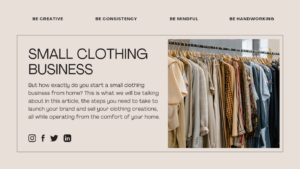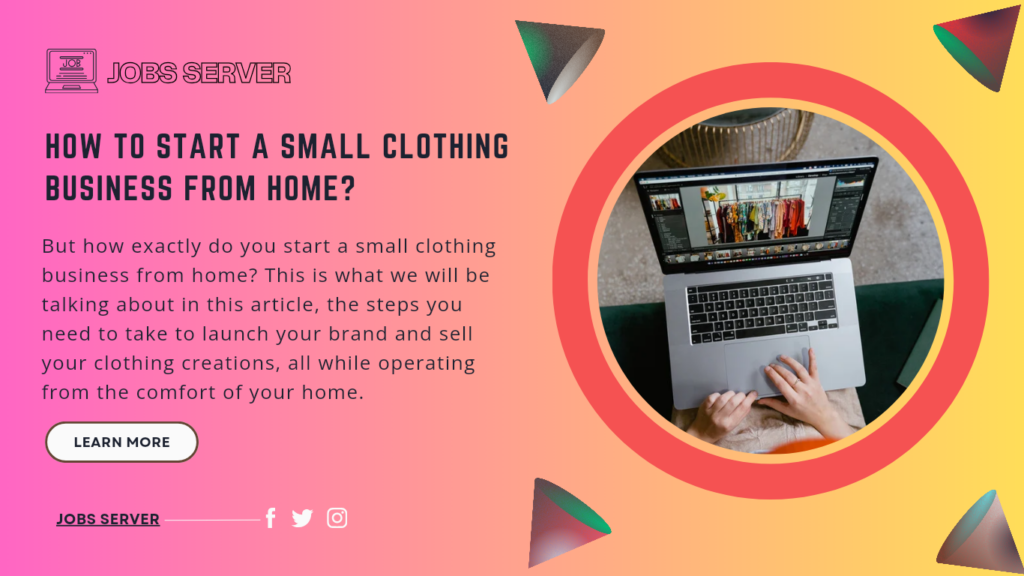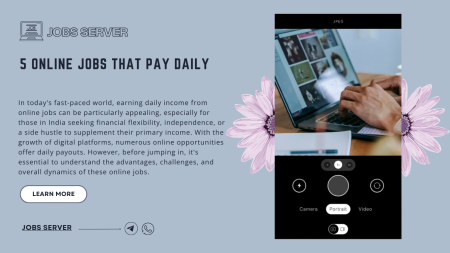HOW TO START A SMALL CLOTHING BUSINESS FROM HOME?
INTRODUCTION
Starting a small clothing business from home can be exciting and profitable. Whether you’re a fashion fan with a love for unique styles or someone looking to make extra income from your creativity, launching your clothing line without the overhead of a storefront is appealing. The flexibility of working from home, the ability to set your hours, and the growth potential make this business opportunity both practical and potentially profitable. But how exactly do you start a small clothing business from home? This is what we will be talking about in this article, the steps you need to take to launch your brand and sell your clothing creations, all while operating from the comfort of your home.
IMPORTANT OF STARTING A SMALL CLOTHING BUSINESS FROM HOME
Before diving into the steps, it’s worth reflecting on why this particular business model works so well for so many. First, the fashion industry is massive, and there is always room for new brands with unique perspectives. The demand for handmade, custom, and sustainable fashion has grown rapidly, giving small home-based clothing businesses an edge in targeting niche markets. Moreover, technology

And social media make it easier than ever to start from scratch. You can create an online store, market on social media, and even ship your products globally from your living room.
STEP-BY-STEP ON HOW TO START YOUR SMALL CLOTHING BUSINESS FROM HOME
1. LOOK WHERE YOU SPECIALIZE AND TARGET AUDIENCE
Every successful clothing business has a clear Specialty and audience. You can’t just make clothes for “everyone” and hope to stand out. Instead, think about what makes your brand different. Are you creating eco-friendly pieces? Do you specialize in minimalist designs? Are you catering to a particular age group, body type, or style preference? All this matters when you want to start a clothing brand.
Before I started blogging I first owned a clothing business, When I first started, I chose to focus on sustainable streetwear for young professionals. This narrowed my focus and helped me connect with a community that cares about both style and the environment. Knowing who you’re designing for will inform every decision you make, from the materials you use to how you market your products.
2. DO SOME MARKET RESEARCH
Once you’ve identified where you specialize, it’s time to see what the market looks like. Research competitors within your Field and see what they’re doing right, and what they’re missing. Analyze pricing, marketing strategies, and customer feedback. This step will give you insights into how to position your brand in a crowded marketplace.
Use tools like Google Trends, Instagram, and Pinterest to see what’s popular in your niche and how trends are shifting. This will help you stay relevant and ahead of the curve.
3. CREATE A BUSINESS PLAN
Even though you’re working from home, you need a business plan. It doesn’t have to be overly formal, but having a roadmap helps you stay on track. Your business plan should outline your Specialty, target audience, goals, financial projections, and marketing strategy.
A crucial part of this plan is your budget. You need to calculate how much capital is required to get started. Your budget might include fabric, tools, design software, website hosting, and marketing costs.
ALSO CHECK
4. DEVELOP YOUR BRAND IDENTITY
Your brand is more than just the clothes you make; it’s how you’re perceived by your audience. Develop a strong brand identity that resonates with your target market. This includes your business name, logo, and overall visual aesthetic. Your brand’s story should align with your clothing line, offering a cohesive and memorable experience for your customers.
I remember when I was in a clothing line, I can still recall how I spent weeks designing my logo and coming up with a brand story that aligned with the eco-conscious values of my customers. It paid off in the long run because people felt connected to the story behind the clothes, not just the designs.
5. SOURCE MATERIALS AND CREATE SAMPLES
Now that you have a clear plan and brand identity, it’s time to start creating. Begin by sourcing materials that fit your budget and your brand’s values. If sustainability is important to your brand, look for organic fabrics or deadstock materials.
Once you have your materials, create some sample pieces. These prototypes will help you refine your designs and get feedback before moving into full production.
6. ESTABLISHED YOUR WORKSTATION
Setting up a designated workspace at home is essential for productivity and organization. Depending on the scale of your business, you might need a dedicated room or even just a corner of your living space for your sewing machine, fabrics, and design tools.
You’ll also need a storage system for your materials and finished products to keep everything organized and ready for orders.
7. PICK OUT THE RIGHT SALES PLATFORM
Now that the work is done, selling your products requires an online platform where customers can easily browse and purchase. Some of the most popular platforms for small clothing businesses include:
- Etsy (for handmade and vintage items)
- Shopify (ideal for setting up your online store)
- Instagram, and WhatsApp (great for direct sales and brand building)
Take your time to choose a platform that fits your business goals. A website with an integrated store (such as Shopify) gives you full control of your brand, while social media platforms can help you reach a wider audience.
8. PUT PRICE TAG ON YOUR PRODUCTS
Pricing can be tricky, especially when you’re just starting. You want to cover your costs and make a profit, but you also need to stay competitive. Consider the cost of materials, labor, packaging, and shipping when setting your prices.
Don’t forget to factor in the value of your time! While it’s tempting to underprice your products when you’re starting, remember that your time and skill have value.
9. FORM A MARKETING STRATEGY
Marketing is key to raising your small clothing business from home. Luckily, social media platforms like Instagram, Facebook, and WhatsApp channel are tailor-made for showcasing fashion. Create visually appealing content that showcases your designs and tells your brand’s story.
You can also partner with influencers or bloggers in your niche to help spread the word. Remember to engage with your audience consistently, the more people feel connected to your brand, the more likely they are to support it.
When I was in the clothing business I first launched my Instagram account months before I started selling. By the time I launched my first collection, I had a small but loyal following that was excited to buy from me on day one.
10. UNVEIL YOUR COLLECTION AND PROMOTE IT
Now comes the exciting part, launching your clothing collection! Announce your launch date on social media, send emails to your list of potential customers, and consider hosting a virtual launch event.
It is very important to use promotions like discounts for first-time buyers or limited-time offers to create urgency. Make it easy for your audience to share your brand with their friends by encouraging them to tag you in their photos.
11. BUILD RELATIONSHIPS WITH CUSTOMERS
One of the biggest advantages of starting small is the ability to build strong relationships with your customers. You need to offer excellent customer service, respond to questions promptly, and show appreciation for their support. Small touches, like handwritten thank-you notes in your packages, go a long way in creating loyal customers.
ADVANTAGES OF STARTING A SMALL CLOTHING BUSINESS FROM HOME
- Without the need for a physical store, your overhead costs are significantly lower. You won’t have to worry about rent, utilities, or other expenses that come with running a shop.
- You have the freedom to work at your own pace and set your schedule. This is especially valuable if you’re balancing other commitments, such as a full-time job or family.
- Running your own clothing business online allows you to express your creativity fully. You’re in charge of every aspect, from design to marketing.
- Thanks to e-commerce, you can reach customers all over the world from the comfort of your home. With the right marketing strategy, your designs can gain international recognition.
DISADVANTAGES OF STARTING A SMALL CLOTHING BUSINESS FROM HOME
- While you don’t have the overhead of a shop, there are still costs involved. Sourcing quality materials, purchasing sewing equipment, and paying for an online store all require capital.
- Running a business from home requires discipline. It can be easy to get distracted or fall into the habit of overworking since your workspace is also your living space.
- As your business grows, managing everything from home can become difficult. You may need to invest in additional storage space or consider hiring help to keep up with demand.
- Depending on the size of your home, you may face challenges with space. Managing inventory, materials, and shipping supplies can quickly outgrow your home environment.
FINAL THOUGHTS
Starting a small clothing business from home is a fulfilling way to combine creativity with entrepreneurship. By carefully planning, staying true to your brand, and building relationships with customers, you can turn your passion into a successful business. While there are challenges, the advantages of flexibility, low costs, and creative control make it an attractive option for fashion-forward entrepreneurs. Now that you know how to start a small clothing business from home, it’s time to take the first step and turn your fashion dreams into reality!
SOME ASKED QUESTIONS ON HOW TO START A SMALL CLOTHING BUSINESS FROM HOME
1. What is the first step to starting a small clothing business from home?
The first step is identifying your niche and target audience. Decide what type of clothing you want to create and who your ideal customer is. This will guide your design choices and marketing strategy.
2. Do I need a lot of money to start a home-based clothing business?
You don’t need a fortune to get started, but you do need some capital. Focus on essentials like materials, a sewing machine, and setting up an online store. Start small, and you can scale as your business grows.
3. How do I sell my clothing without a physical store?
You can sell your clothing through online platforms like Shopify, Etsy, or even social media like Instagram. Building a website is another great option to control your brand and offer a seamless shopping experience.
4. Can I start a clothing business from home with no experience?
Yes! Many successful home-based clothing businesses were started by beginners. You can learn the necessary skills through online courses, YouTube tutorials, or even hands-on practice. Start simple and improve as you go.
5. How do I price my clothing items?
When pricing, consider the cost of materials, time, and other expenses. Make sure to leave room for profit but stay competitive. Start by researching prices from similar brands to find a range that works.
6. What is the best way to market a home-based clothing business?
Leverage social media, particularly platforms like Instagram and Pinterest, to showcase your designs. Consistent posting, engaging with followers, and working with influencers in your niche can help grow your brand.
7. How can I balance working from home while running my clothing business?
Set up a dedicated workspace and stick to a schedule. Balancing work and home life requires discipline, so having clear boundaries helps you stay productive and focused on your business.
8. What legal steps should I take before starting a home-based clothing business?
It’s essential to register your business, get a tax ID, and check local regulations. Depending on where you live, you may need permits to run a business from home.
9. How do I stand out in a crowded fashion market?
Focus on what makes your brand unique. Whether it’s your designs, sustainability efforts, or personal stories, find what sets you apart and use it to connect with your audience.
10. Can I start my clothing business while keeping my day job?
Yes, many entrepreneurs start their clothing businesses part-time. Use your free time wisely to plan, design, and grow your business before transitioning to full-time.
11. How long does it take to see profits from a home-based clothing business?
It depends on your efforts and market conditions. Some businesses see profits in a few months, while others take longer. Consistency in marketing and delivering quality products will help you grow faster.
12. What are the most common mistakes when starting a clothing business from home?
Common mistakes include not planning properly, underpricing, and failing to market effectively. Be sure to research, plan, and promote your business from the start.
13. Can I make custom clothing from home?
Yes, custom clothing is a great way to attract clients looking for personalized designs. You can offer customization through online consultations or orders.
14. How do I manage inventory for my home-based clothing business?
Start small and keep track of materials and finished products. As your business grows, invest in storage solutions or software to help manage your inventory efficiently.
15. Do I need a sewing machine to start a clothing business?
If you plan to make the clothes yourself, a sewing machine is necessary. However, if you plan to outsource production, you may not need one at the start.





